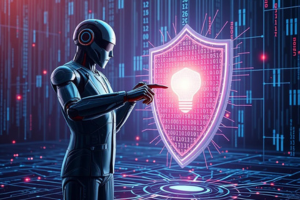Cybersecurity & AI

The Role of AI in Enhancing Cybersecurity Measures
Imagine a world where cybercriminals are no longer one step ahead. A world where breaches are thwarted before they even happen, and sensitive data remains secure. This is not science fiction—it’s the reality that artificial intelligence (AI) is shaping for the future of cybersecurity.
In a time when headlines are dominated by data breaches and businesses are losing millions due to cyberattacks, AI has become a transformative tool. But how exactly does it work, and why is it the ultimate ally in the fight against cyber threats? Let’s dive into the fascinating intersection of AI and cybersecurity.
The growing complexity of cyberthreats
Traditional cybersecurity methods rely on predefined rules and patterns to detect threats. While effective to a degree, these methods fall short against the ever-evolving tactics of hackers. Modern cyberattacks are increasingly sophisticated, leveraging techniques like social engineering, zero-day exploits, and advanced persistent threats (APTs) to infiltrate systems undetected.
This is where AI comes into play. Unlike traditional methods, AI thrives on adaptability. By analyzing vast amounts of data in real time, AI can identify patterns and anomalies that might evade human detection. This makes it an invaluable tool for preemptively identifying and neutralizing threats.
How AI Strengthens Cybersecurity
- Proactive Threat Detection
AI excels at monitoring network traffic and user behavior to detect anomalies. For instance, AI can flag the use of an employee's login credentials from two different countries within minutes as suspicious and block access until verified. This level of vigilance guarantees the identification of threats before they escalate.
- Machine Learning in Action
Machine learning (ML), a subset of AI, allows systems to learn from historical data. By training on past cyberattacks, ML models can predict and identify similar attack patterns in the future. This continuous learning cycle ensures that cybersecurity systems stay ahead of emerging threats.
- Automated Response Systems
In the face of a cyberattack, speed is critical. AI-powered systems can respond to threats in milliseconds—far faster than human intervention. Whether isolating infected devices or deploying countermeasures, AI minimizes the damage caused by breaches.
- Reducing human errors
Human error remains one of the leading causes of cybersecurity breaches. Phishing scams, weak passwords, and misconfigurations are common vulnerabilities. AI assists by automating routine tasks, providing real-time alerts, and offering advanced training simulations to educate employees.
Real-world applications of AI in cybersecurity
- Financial Sector
Banks and financial institutions are prime targets for cyberattacks. AI-driven systems monitor transactions for fraud, detecting unusual spending patterns and halting unauthorized activities.
- Healthcare Industry
AI safeguards sensitive patient data by identifying breaches and ensuring compliance with strict regulations like HIPAA.
- E-Commerce
Retail platforms rely on AI to protect customer data and prevent payment fraud during online transactions.
Challenges and Ethical Considerations
Despite its promise, the integration of AI into cybersecurity isn’t without challenges. Hackers' potential weaponization of AI systems is a major concern. Cybercriminals can use AI to develop more sophisticated attacks or bypass security measures. Furthermore, the dependence on AI prompts ethical concerns regarding privacy and the potential for blocking legitimate users due to false positives.
The Future of AI in Cybersecurity
As cyber threats continue to evolve, the role of AI in cybersecurity will only grow. Innovations such as quantum computing and advanced ML algorithms promise even greater security capabilities. However, responsible use of these advancements will require collaboration among AI developers, cybersecurity experts, and policymakers.
Conclusion
AI is revolutionizing the cybersecurity landscape, offering unparalleled capabilities to detect, prevent, and respond to cyber threats. While challenges remain, the potential benefits far outweigh the risks. By embracing AI, we can create a digital environment where security is proactive, robust, and ever-evolving.
So, the next time you hear about AI in cybersecurity, remember: it’s not just about protecting systems; it’s about securing our digital future.